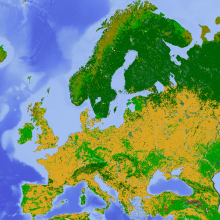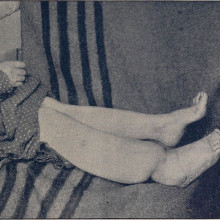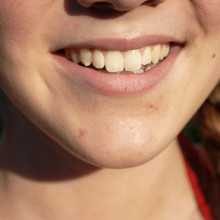Imagine designing bacteria that can do whatever you want - from cleaning up oil spills to churning out the latest cancer treatments - ordering the biological parts online and building it in a couple of weeks. This is no longer the stuff of dreams, but the reality of synthetic biology. Plus, tracing European genes, how parasites manipulate our immune systems, I take part in a research project to find out if sociability is in my genes, and our gene of the month is looking for wedded bliss.
In this episode

01:11 - Richard Kitney - Engineering life
Richard Kitney - Engineering life
with Richard Kitney, Imperial College
Kat - Synthetic biology may be a relatively new term, but there's growing excitement about its potential. In simple terms, it's all about engineering life - breaking down the DNA instructions that tell cells to make particular molecules into smaller component parts or modules that can be stuck together in entirely new ways, such as creating bacteria bearing novel enzymes that can eat up oil spills, or yeast cells that can produce lifesaving drugs. To find out more about synthetic biology, and where it all started, I spoke to Professor Richard Kitney, co-director of the Imperial College hub for synthetic biology.
Richard - Basically, the start of synthetic biology really occurred with the - a good point is with the initial sequencing of the human genome which was started around 2001. The reason for that is because in order to sequence the human genome, it was necessary to develop technology to be able to read DNA accurately and at that time, reasonably inexpensively. And so, the ability to read DNA led to the idea that maybe it might be possible to actually modify DNA to produce various things like changes in proteins or possibly, biological devices.
Kat - Because going back to the late '70s and early '80s, people were using basic genetic engineering techniques to do this kind of thing, what made it different with the advent of sequencing?
Richard - With the ability to accurately sequence DNA came the idea that it might be possible to engineer biology. And so, that then led to the concept of applying engineering principles and specifically, standardisation, modularisation. So, making things into modules and being able to accurately define the biology in terms what's called characterisation. So, that was another key difference.
Kat - What do we mean when we refer to taking this engineering, this modular approach, the kind of bits and bobs approach to biology?
Richard - When you put DNA into a cell, that's natural DNA, the cell responds in a particular way to produce defined proteins which lead through to things like skin cells for example. You can think of that as being the DNA that is as being the instruction set for the cell. So, it's almost like a computer program for the cell. If you modify the DNA, according to human design, you put it into the cell so this is now synthetic DNA - which by the way is produced chemically - then the cell responds by following essentially the computer program or instruction set from the DNA and produces something different, for example, oil or various kinds of biofuels so that's another example, or various kinds of healthcare products.
Kat - So, it's effectively just designing a biological recipe that can make anything you can imagine. If you can write it into DNA, a cell can make it. That sounds very simple. Does it always work that way?
Richard - Well, that's the basic concept. And then of course, you have to then optimise the process. So, optimising the process involves obviously a lot of science but particularly, what kind of cell are you going to use. Some cells are better than others for different applications.
Kat - And is it always bacterial cells or yeast cells or are there any human cells that you can stick these things into as well?
Richard - Well, the majority of the field still works on bacterial cells. In terms of mammalian cells, yes, there is a field of synthetic biology which is beginning to develop which is using mammalian cells for different applications.
Kat - What sort of applications is this kind of technology suitable for? What can you do with it?
Richard - Well, there are wide range applications. So, I think you have to go back to the basic strategy, and the basic strategy employed by ourselves and many other groups around the world is the idea that you can design and build what's called platform technology. So, this is technology which works across a wide range of applications. So, you don't actually need to modify the basic technology works for different applications. So the applications would be in areas such as healthcare for example, the development of biosensors of various kinds, the development of biological logic - so, this is the idea that you can develop the direct equivalent to electronic logic, electronic computing but in biology - various kinds of new materials, different ways for bioremediation. So, cleaning up oil spills, et cetera, using bacteria with have been programmed to eat oil. So, they are some examples.
Kat - You talked about platforms and technology. So, it's the idea that there's just a range like Lego bricks or component parts and someone says, "I want to do this. That means I need this, this and this," and we just glue them together, put them in a cell and here we go. It sounds incredibly powerful.
Richard - Yes. So, the basic idea is that you can take standard components which are well-defined. So, by a standard component, what I mean is a particular section of DNA which has been synthetically produced and human designed. But when you put that into a particular kind of cell, you will get a particular kind of response which is well-defined and that's called characterisation. All these bio parts are stored in something called a registry which is essentially a database and you decide on the basis of a particular design which particular standard components or bio parts you want to use to make that design work.
Kat - It's a very new way of looking at something that's kind of almost seen as the squishy science of life and treating it as an engineering problem.
Richard - Yes. Well I mean, many people in the field think about synthetic biology as being engineering biology and that is a very common term which is used for example in the United States in relation to synthetic biology. So, it's the application of engineering to the engineering and biology. That's essentially what synthetic biology is.
Kat - There's lots of potential applications for this kind of technology and you're obviously talking to a lot of researchers, and a lot of companies that are interested. Is there anything that you've seen that you've gone, "Wow! That's really, really clever!"?
Richard - Well, I think one of the really clever things frankly is, one of my colleagues has produced penicillin using yeast. I think that's pretty clever. There are also various researchers in the world that are now producing synthetic spider silk and that will lead to much stronger lighter materials. So, they're two important examples.
Kat - Richard Kitney, from Imperial College's synthetic biology hub.

08:20 - James Field - Life in a library
James Field - Life in a library
with James Field, Imperial College London
Kat - Also while I was at Imperial I caught up with James Field, who's just launched a new company called LabGenius, capitalising on the growing interest in synthetic biology. I started by asking him what first got him into it.
James - It all started when I was an undergraduate at Imperial College. In my third year, it was possible to take a module in synthetic biology. It was really the first time that anyone said, "Biology is not just a descriptive science. You can play around with it. You can build things and you can create things." So, it really stimulated us to kind of think about what we could create out of biology, out of living matter. And then out of that, when I graduated, I took part in the iGEM competition so that was back in 2009.
Kat - What's the iGEM competition? It sounds fun.
James - Well, the iGEM competition is the International Genetic Engineering Machine competition and it's this incredible organisation called the iGEM Foundation that puts it on. Every year, undergraduates from all over the world descend on Boston. They take to Boston a presentation that describes an organism that they would've built over the course of the summer. So, the undergraduates are given lab space and equipment so that they can design, build, and test an organism to do a specific task.
Kat - And what was yours?
James - So in 2009, the idea was to build an organism that was able to create a drug and then could effectively turn itself into a pill. So in this case, it was a microbe that would produce an enzyme and then it would delete its own genome and grow a shell so that it could safely transport the enzyme through the stomach into the intestine.
Kat - So, that kind of enabled you to catch the bug so to speak for a synthetic biology. How did you take this forward? What's the question that you're trying to answer with the company that you've set up?
James - The question at the heart of the company which is called Lab Genius is: Can living matter be designed in a fundamentally different way to the way in which we design everyday objects around us? So, an engineer might design a table by drawing up a schematic of one or three or five tables, but the beauty of synthetic biology is that you can create designs for thousands upon thousands of different variants of a particular biological component and then you can test those simultaneously and identify designs that perform particularly well. So, it's a fundamentally different way in which you can engineer matter.
Kat - It's kind of the way that evolution does it I guess. It's kind of tweak, test, tweak, test, try, mutate.
James - It's exactly the way that evolution does it. So the only different, rather than making a series of small number of mutations over time, we make a very, very, very large number simultaneously. So, we can effectively accelerate the whole process of evolution dramatically. By controlling the conditions of selection, it's possible to screen millions upon millions of different genetic designs to find the ones that perform best.
Kat - So effectively, it's like having a massive library of different DNA instructions that people can just rifle through to find the ones that they want for the thing that they're trying to make.
James - That's exactly right. The beauty of synthetic biology is it allows you to manufacture those different DNA designs. And then once you've made those designs, you can in parallel put them into many hundreds of thousands of different microbes and then it's the microbes that each read those instructions that are encoded onto DNA and then you can screen for the different phenotypes of the microbes.
Kat - What sort of things do you think people might be interested in in rifling through your library for?
James - So in the future, people may be trying to build organisms that perform differently to the ones that we have around us today. But right now, there's a lot of emphasis going on on redesigning proteins to do functions differently. So for example, it may be the case that a pharmaceutical company who are making an antibody want to make that antibody so it binds to its target more tightly. In that case, you could use this approach for screening millions upon millions of antibodies. So, at the moment, the real application area for this technology is to fine-tune proteins to get them to do exactly what you want them to do.
Kat - Overall, synthetic biology seems like an incredibly powerful technique that's relatively simple to start using but has enormous numbers of potential applications. How exciting does it feel to be part of this and at the beginning really of the journey here?
James - It feels absolutely incredible. Just the ability to sit down at the computer and to write an algorithm that will design millions of sequences, all of those sequences, assemble them and be testing them within a week. It's just absolutely incredible to do.
Kat - And presumably, not needing millions and millions of pounds and an enormous company and an enormous factory to do it.
James - Right, exactly. The beauty is that evolution has built all of the machinery that you require to do synthetic biology. It's just the synthetic DNA that was the last component that was missing and now, we have access to that.
Kat - So say, if I came to your library and I found a piece of DNA that built exactly the molecule I wanted to build, how could I go about testing it? Could I do it in my garage? What would I need to do next?
James - Well, up until now, the barrier to entry to anyone who wants to perform a synthetic biology experiment has been relatively high although that's all changing. So, whilst you can code up your DNA sequence on the computer, you can now also have it built and tested in the Cloud. So, there are a number of companies called Cloud Labs where you're able to send them you're able to send them your DNA sequence, made even virtually just a string of letters and also, the certain experiments that you want conducted and it will all be done remotely.
Kat - Could anyone do this? I'm sitting at home in my flat in East London and I think, "I wonder if I could design something that would do this?"
James - So, you could certainly design it. If you wanted the DNA synthesised, the different companies will each have their own set of screening procedures to make sure you're not trying make anything nefarious. So, there are safeguards in place.
Kat - What sort of costs are we talking about?
James - Certainly, DNA synthesis, the price of actually making your gene has dropped dramatically over the last few years. So, you can have a gene sequence made from anything up to £500 pounds. To get it tested is often a lot more expensive. However, Cloud Labs are bringing those costs down.
Kat - It almost seems like it's turning the traditional ways of doing drug development and design and this kind of thing completely on their head and opening it right up. It's really exciting.
James - Yeah. It's creating a lot more opportunities and it's opening the field to many more players, so it's going to be really exciting to see what happens in this space over the next few years.
Kat - It seems like a really exciting area for people who are passionate about technology that could potentially really make a difference in this world.
James - And that's the beauty of the field. It's completely interdisciplinary. So, whoever you are, whatever your skillset, you can bring value to the field of synthetic biology.
Kat - James Field from the company LabGenius, based at Imperial College's synthetic biology hub.

15:44 - Tracing Europe’s genes
Tracing Europe’s genes
with Cristian Capelli, University of oxford
The papers may be full of stories about refugees coming to Europe, fleeing war and hardship in other parts of the world, but when we look back through history, this is nothing new. A new study led by researchers at the University of Oxford shows that there's been extensive immigration into and around Europe for centuries, revealed by the mish-mash of variations in the DNA of today's Europeans, as Kat Arney hears from study lead author Cristian Capelli...
Cristian - Basically, what we do is to look for fragments of DNA that are present in human population that are shared with other populations. This sharing could possibly be the result of events of gene flow that occurred in the past.
Kat - And by gene flow, presumably, you also mean people flow.
Cristian - When people move close to each other, also a result an exchange of genes. So yes, the result of gene flow in this case, is also the result of people migrating and getting in contact, and exchanging genes, yes.
Kat - Exchanging genes sounds very romantic.
Cristian - Well, I would say that's yes.
Kat - How many people did you actually look at and what sort of level of detail were you going into to look at their DNA, to look at their genomes and see what bits have come from where?
Cristian - Well, we looked at approximately 2,000 people. A thousand of them pretty much coming from western Eurasia and a thousand coming from a side of this area.
Kat - How have you gone about analysing the DNA of these 2,000 people that you've looked at?
Cristian - Well, the classical approach is to use the samples according to the label that has been provided when the samples have been collected. For example, Italians. what we instead have done is that we used their genetic data to identify the groups that we wanted to analyse. In this way, we removed any possible subdivision that was present in the sample. So in this way, basically, we removed some level of confounding that could be present. In this way, we're able to maximise our chance to identify the signature that we were interested in.
Kat - So broadly, paint me a picture of what your results show about the different populations in this area.
Cristian - We found signatures that are related to what we already know in the history of Europe but also, evidence for episodes that are not well-recorded in the history of the region. So for example, presence of North African genes in Iberia in a period that is related to the presence of the Muslim kingdom in Spain and Portugal. At the same time, we also found contributions from Africa in Spain and in southern Italy that are at a different time and a later time. Such contribution is not present in the history books. So, we're somehow surprised but at the same time excited because we were able to identify those different events. But at the same time, we see that a lot of those events that are occurring within Europe are centred around a thousand years ago that seems to be a period in time where there was a lot of things happening in the continent as well. A lot of migration, contacts, and possible gene flow occurring and leaving those signature across the population in the area.
Kat - How well does your data tie up with information from other sources, from other genetic studies or historical studies?
Cristian - Well, as I said, there are a number of events that align very well. Others seems to be less relevant in terms of the genetic contribution. As for example, one thing that we noticed was that despite the fact that the Romans have been conquering very much Europe, North Africa, and the Middle East at a certain point in time, there's nothing like a Roman contribution, that might be an Italian contribution, scattered across Europe in a systematic way. Clearly, there is a difference between cultural and political occupation and on the other side, the demographic impact that those events might have had. So, there's no clear answer to your question in a sense that yes, we see a lot of events that align very well. But also, we found a lot of events that we don't know anything about, specifically from the history of this region of the world.
Kat - Cristian Capelli from the University of Oxford, and that study was published in the journal Current Biology.

20:22 - Michael Kimber - Parasites in charge
Michael Kimber - Parasites in charge
with Michael Kimber, Iowa State University
Kat - You may never have heard of the disease lymphatic filariasis, but it affects 120 million people in 70 countries around the world, causing dramatic swelling of the limbs and other parts of the body, known as elephantiasis. It's caused by tiny parasitic worms, transmitted between people by mosquito bites, which can lie low in the body for many years, hiding from the immune system. But how do they do that? Michael Kimber from Iowa State University has been finding out.
Michael - People have kind of looked previously at various secretions, things that the parasites release whilst they're inside the host, but up to this point, the nature of those secretions, they really haven't given us much of an indication as to how these parasites manipulate people in order to cause the disease that they do. What we wanted to do is to take a more detailed look at that interaction.
Kat - What did you do to study this in more detail?
Michael - Recently, there has been a really invigorated research focus on structures called exosomes. Exosomes are a particular type of small vesicle, extracellular vesicle released by many, many cell types. You can find these exosomes having important functions in things like cancer, other infectious diseases, autoimmune diseases, even neurodegenerative diseases. The consensus seems to be that these exosomes act as cell-to-cell effectors. So, what they do is they carry a cargo that is capable of performing lots of biological function from the cell where it's released to a target cell and then it can manipulate the biology of that target cell.
Kat - So, kind of like a little extracellular postman.
Michael - In many respects, carrying a very dangerous package if you're a host organism, yes.
Kat - How did you go about trying to look for these exosomes in this infection?
Michael - With these parasites, we have the ability to maintain them in vitro. So, we can take them out of the host and keep them alive for a while and study the things that they secrete. So, we maintain some parasites in culture and collected their secretions and profiled them with various techniques.
Kat - What's in them and what are they doing more importantly?
Michael - When we looked at the cargo of the exosomes secreted by these parasites, we found a preponderance of small RNAs called microRNAs.
Kat - These are very interesting aren't they? They are very hot right now.
Michael - Very hot right now. So, they were identified probably 15, 20 years ago, maybe as far back as that. They seem to be agents of genetic change. So, these are small RNA species that humans and other animals, even plants use to control the expression of genes. The identification that parasites secrete microRNAs was interesting because it opens the door to the idea that a parasite is secreting an agent of genetic change and therefore, manipulating gene expression within the host.
Kat - So, the idea would be that these little parcels produced by the parasite are somehow turning genes on and off in human cells. That's got pretty big implications for understanding the disease.
Michael - Yeah, I think so. It's a very intriguing paradigm and certainly, it's a hypothesis that seems to be supported by other studies that are emerging at this time. Other infectious diseases, the same thing is also observed where these pathogens seem to be able to secrete these exosomes containing microRNAs to specifically alter host immune responses and create conditions favourable to the infecting agent.
Kat - Iowa State University's Michael Kimber, and that study was published in PLOS Neglected Tropical Diseases.

24:23 - Eiluned Pearce - Genes and sociability
Eiluned Pearce - Genes and sociability
with Eiluned Pearce, University of Oxford
Kat - Are you one of those people who's the centre of attention in the pub or at a party? Or would you rather keep yourself to yourself? And could the difference be encoded in the genes? Eiluned Pearce, from the Social and Evolutionary Neuroscience Research Group at the University of Oxford, is searching for the genes involved in sociability - and as a self-confessed social animal myself - I was keen to get involved. I caught up with her at the recent British Science Festival in Bradford,and asked her to talk me through the study.
Eiluned - People have looked at specific genes and have found that there is a genetic association with particular social behaviours so things like empathy. So how easy you find it to see yourself in someone else's shoes. What we're doing in this study is to look at six different genes and to try and look at the interactions between them. So instead of just looking at one gene or one particular aspect of social behaviour or social thinking, we're looking at a whole range to try and understand the complexity of social behaviour.
Kat - What sort of genes are they? What do they do?
Eiluned - So, one of them is the oxytocin receptor gene. So oxytocin is a chemical in the brain associated primarily with love, so romantic bonds, mother-infant bonds. Another one we're looking at is testosterone which is the male hormone.
Kat - The wahay! kind of hormone.
Eiluned - Exactly and also works in the brain. We're also looking at beta endorphin which associated with runner's high. So, it's basically the brain's morphine. So it gives you a high and we think that's associated with social bonding as well.
Kat - So, if you get more endorphin, you're kind of feeling good, and you want to hang out with people.
Eiluned - Exactly, yes.
Kat - We're here at the British Science Association Science Festival and I have just taken part in your study.
Eiluned - You have.
Kat - The first thing I did was signed a nice consent form so that I understood the study. That's very important.
Eiluned - Yes, exactly.
Kat - And so then they put my hands on a scanner. What was that for?
Eiluned - So, what we're doing there is measuring the length of your second digit so your pointing finger, and your fourth digit, so your ring finger. And the ratio between those two gives an indication of the amount of testosterone you were exposed to in the womb, so before you were born. And that's linked to various behaviours in adults. So things like aggression, things like affiliation. So again, associated with social behaviour.
Kat - And then I was taken to a laptop and sat down and made to do a kind of question, lots of pictures of people's eyes and then asking me some personal questions about my friends, my family, my support networks.
Eiluned - The eye question was trying to work out how good you are at identifying emotions in other people's faces. That's an ability associated with empathy so this, being able to put yourself in someone else's shoes and understand them. And then there was questions about how you feel towards romantic partners and how you feel towards your best friends. So, there, we're trying to understand kind of pair-bond behaviours, so between two people, very intimate relationships. And there were also questions about your wider social network, so the people you go to for support, whether you talk to your neighbours and that kind of thing, and also, how you felt towards your community. So, we're covering a huge range of social behaviours.
Kat - And then finally, I was given a plastic test tube and I basically had to fill it with spit.
Eiluned - You did! So, from the spit, we will extract your DNA to look at these particular genes. All of the data you gave us was anonymous. So, all of it was connected by a number, not associated with your name. So unfortunately, we can't tell you what your genes are or how sociable you are as an individual. All we can tell people and all we will get out of this is to understand group level differences between different versions of these genes, and whether they're associated with different versions of social behaviour.
Kat - What sort of size of study and what sort of associations are you trying to find?
Eiluned - Firstly, we wanted 600 and it's going pretty well. The data we have is encouraging so now, we're trying to get a thousand which is still a fairly small sample for a genetic study, but this is the first time we've attempted this. So, it's a kind of pilot look at whether there are associations and maybe we'll expand it further.
Kat - Oxford University's Eiluned Pearce, and she's hoping to publish her findings in a couple of years, so I'll be checking back then.

28:43 - Gene of the Month - Matrimony
Gene of the Month - Matrimony
with Kat Arney
And finally it's time for our Gene of the Month, and this time it's Matrimony. Another fruit fly gene, Matrimony encodes a protein that's found at high levels in fruit fly eggs, but rapidly vanishes after the egg is fertilised and starts growing into a little maggot. It gets its name from the fact that it's responsible for holding together pairs of chromosomes in the final stages of cell division when an egg is formed - a process known as meiosis - before they separate when the egg is fertilised, at the very beginning of development.









Comments
Add a comment